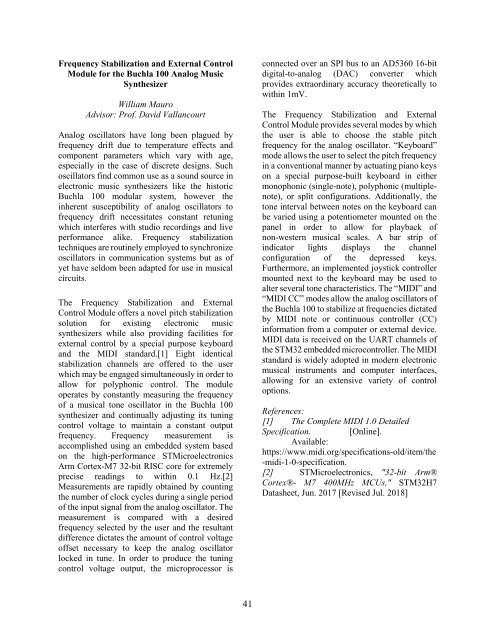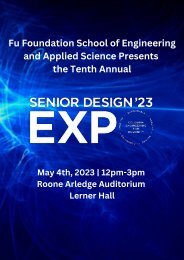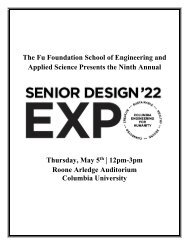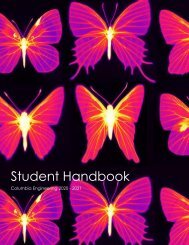Senior Design Expo 2019
The Senior Design Expo, held annually in May at Columbia University, is an opportunity for Columbia Engineering students to showcase what they have learned in their foundational math and science courses together with their engineering courses in innovative, creative, and purposeful designs and prototypes. Each year the Expo showcases more than 60 projects across all nine departments. Projects have included cutting-edge robotics, the New York City subway system, language technology, proposals for bridges to span the Hudson river, and much more.
The Senior Design Expo, held annually in May at Columbia University, is an opportunity for Columbia Engineering students to showcase what they have learned in their foundational math and science courses together with their engineering courses in innovative, creative, and purposeful designs and prototypes. Each year the Expo showcases more than 60 projects across all nine departments. Projects have included cutting-edge robotics, the New York City subway system, language technology, proposals for bridges to span the Hudson river, and much more.
You also want an ePaper? Increase the reach of your titles
YUMPU automatically turns print PDFs into web optimized ePapers that Google loves.
Frequency Stabilization and External Control<br />
Module for the Buchla 100 Analog Music<br />
Synthesizer<br />
William Mauro<br />
Advisor: Prof. David Vallancourt<br />
Analog oscillators have long been plagued by<br />
frequency drift due to temperature effects and<br />
component parameters which vary with age,<br />
especially in the case of discrete designs. Such<br />
oscillators find common use as a sound source in<br />
electronic music synthesizers like the historic<br />
Buchla 100 modular system, however the<br />
inherent susceptibility of analog oscillators to<br />
frequency drift necessitates constant retuning<br />
which interferes with studio recordings and live<br />
performance alike. Frequency stabilization<br />
techniques are routinely employed to synchronize<br />
oscillators in communication systems but as of<br />
yet have seldom been adapted for use in musical<br />
circuits.<br />
The Frequency Stabilization and External<br />
Control Module offers a novel pitch stabilization<br />
solution for existing electronic music<br />
synthesizers while also providing facilities for<br />
external control by a special purpose keyboard<br />
and the MIDI standard.[1] Eight identical<br />
stabilization channels are offered to the user<br />
which may be engaged simultaneously in order to<br />
allow for polyphonic control. The module<br />
operates by constantly measuring the frequency<br />
of a musical tone oscillator in the Buchla 100<br />
synthesizer and continually adjusting its tuning<br />
control voltage to maintain a constant output<br />
frequency. Frequency measurement is<br />
accomplished using an embedded system based<br />
on the high-performance STMicroelectronics<br />
Arm Cortex-M7 32-bit RISC core for extremely<br />
precise readings to within 0.1 Hz.[2]<br />
Measurements are rapidly obtained by counting<br />
the number of clock cycles during a single period<br />
of the input signal from the analog oscillator. The<br />
measurement is compared with a desired<br />
frequency selected by the user and the resultant<br />
difference dictates the amount of control voltage<br />
offset necessary to keep the analog oscillator<br />
locked in tune. In order to produce the tuning<br />
control voltage output, the microprocessor is<br />
connected over an SPI bus to an AD5360 16-bit<br />
digital-to-analog (DAC) converter which<br />
provides extraordinary accuracy theoretically to<br />
within 1mV.<br />
The Frequency Stabilization and External<br />
Control Module provides several modes by which<br />
the user is able to choose the stable pitch<br />
frequency for the analog oscillator. “Keyboard”<br />
mode allows the user to select the pitch frequency<br />
in a conventional manner by actuating piano keys<br />
on a special purpose-built keyboard in either<br />
monophonic (single-note), polyphonic (multiplenote),<br />
or split configurations. Additionally, the<br />
tone interval between notes on the keyboard can<br />
be varied using a potentiometer mounted on the<br />
panel in order to allow for playback of<br />
nonwestern musical scales. A bar strip of<br />
indicator lights displays the channel<br />
configuration of the depressed keys.<br />
Furthermore, an implemented joystick controller<br />
mounted next to the keyboard may be used to<br />
alter several tone characteristics. The “MIDI” and<br />
“MIDI CC” modes allow the analog oscillators of<br />
the Buchla 100 to stabilize at frequencies dictated<br />
by MIDI note or continuous controller (CC)<br />
information from a computer or external device.<br />
MIDI data is received on the UART channels of<br />
the STM32 embedded microcontroller. The MIDI<br />
standard is widely adopted in modern electronic<br />
musical instruments and computer interfaces,<br />
allowing for an extensive variety of control<br />
options.<br />
References:<br />
[1] The Complete MIDI 1.0 Detailed<br />
Specification. [Online].<br />
Available:<br />
https://www.midi.org/specificationsold/item/the<br />
-midi-1-0-specification.<br />
[2] STMicroelectronics, "32-bit Arm®<br />
Cortex®- M7 400MHz MCUs," STM32H7<br />
Datasheet, Jun. 2017 [Revised Jul. 2018]<br />
41








